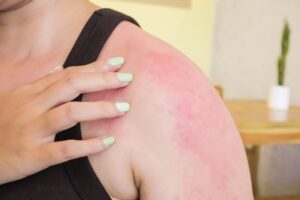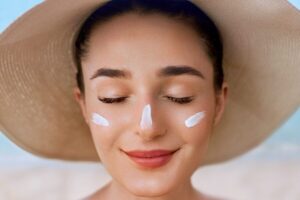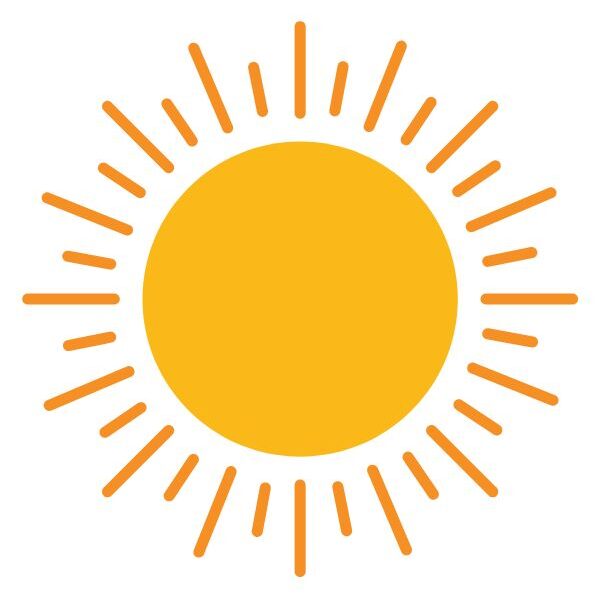*This post may contain affiliate links for which I earn commissions.*
Immediate Relief for Sunburns You Can Try Now!
The warm summer sunshine is wonderful, isn’t it? Summer festivals, gardening, swimming – it’s all so much fun. But oh-oh! Sometimes, we spend too long in the sun and end up burned. The pain, the discomfort – we’ve all been there. But fear not, there are tried-and-true home remedies for sunburn relief that really work. Here are the best methods to soothe the pain and discomfort of sunburn.
Understanding Sunburn

Sunburn is more than just a temporary irritation – it’s a reaction to the skin’s overexposure to ultraviolet (UV) rays from the sun. When UV rays penetrate the skin, they damage the DNA in our skin cells. In response, our body sends extra blood to the affected area to repair the damage, causing that familiar redness and warmth.
Common Symptoms and Severity Levels
Sunburn can vary from mild to severe, and the symptoms usually start to appear a few hours after exposure. Here’s what you might experience:
- Mild Sunburn: Redness, warmth, and tenderness on the affected skin. You might also notice slight swelling.
- Moderate Sunburn: More intense redness and pain, with swelling and blisters that can form on the skin’s surface.
- Severe Sunburn: Skin becomes very red or purplish, extremely painful, with large blisters. Severe sunburn can also lead to symptoms like headache, fever, nausea, and dehydration.
Understanding the severity of your sunburn can help you choose the right treatment. For mild to moderate sunburns, the remedies we’ll discuss should provide significant relief. However, if you’re experiencing severe sunburn symptoms, it’s essential to seek medical advice.
Immediate Relief Methods
When it comes to soothing a sunburn, time is of the essence. The sooner you start treatment, the quicker you’ll feel relief. Here are some immediate relief methods that you can try right now to ease the pain and discomfort of sunburn.
Tea

Black tea is rich in antioxidants and is a wonderful treatment for irritated, damaged, and sunburned skin. Soak a few tea bags in water until the water darkens with the tannins releasing.
- How to Apply: You can put the tea bags directly on your eyelids. Soak a cloth in the cooled tea water and pat this solution on sunburned skin.
- Benefits: Black tea removes the heat, pain, and stinging quickly. The tannins reduce inflammation and help restore the skin’s pH balance.
Potatoes
Potatoes are also well known as a pain reliever for skin irritations. They reduce inflammation and draw heat from your skin.
- How to Apply: Grate two potatoes in a bowl or cut them up and put them in a blender or food processor to make potato mush. Soak cotton balls in the mixture or make a gauze dressing and apply to sunburned areas. Change the dressing several times a day until the pain is relieved.
- Benefits: Potatoes help to cool the skin, reduce swelling, and alleviate pain.
Drink Water

Sunburns will dehydrate your skin, and the best way to help your body heal faster after a sunburn is to drink more water to replenish the liquids your body has lost.
- Tips for Staying Hydrated: Keep a bottle of ice-cold water on hand and drink frequently.
- Benefits: Proper hydration helps your body recover more quickly, supports skin repair, and reduces the risk of heat-related illnesses.
Moisturize
Sunburns dehydrate your skin. Use a gentle, fragrance-free moisturizer such as Aveeno Fragrance-Free Moisturizing Lotion with Natural Shea Butter & Triple Oat Complex.
- How to Apply: Apply moisturizer generously and frequently. For added cooling relief, keep your moisturizer in the fridge before applying.
- Benefits: Hydrating the skin helps to prevent peeling, reduce dryness, and support the healing process.
Vinegar
A vinegar solution applied to sunburned skin is a popular sunburn remedy. Apple cider vinegar is a natural astringent, and it soothes the pain and speeds up the healing process.
- How to Apply: Mix equal amounts of apple cider vinegar and cool water. Soak a cloth or paper towels in the solution and place them over the sunburned areas. Leave the paper towels on until they are nearly dry, then remove them. Repeat this process several times over a few days. Alternatively, add a cup of apple cider vinegar to a cool or lukewarm bath and soak for 30 minutes, or put unfiltered apple cider vinegar into a spray bottle to spritz onto your skin.
- Benefits: The acetic acid in apple cider vinegar will help ease itching and inflammation.
Aloe Vera

Aloe vera is renowned for its soothing and healing properties. It’s a natural anti-inflammatory and can provide a cooling sensation to the affected area.
- How to Apply: Use pure aloe vera gel, either directly from an aloe plant or a store-bought product. Apply a generous layer to the sunburned skin and let it absorb. Reapply as needed, especially when the skin starts to feel hot or dry.
- Benefits: Aloe vera helps to moisturize the skin, promote healing, and reduce redness and discomfort. It’s gentle enough to use as often as needed.
Chilled Cucumber
Cucumbers are incredibly soothing due to their high water content and natural antioxidants, making them perfect for sunburn relief.
- How to Apply: Put one or two chilled cucumbers in a blender to create a paste and apply this mixture directly to sunburned areas.
- Benefits: Cucumbers provide instant cooling relief, reduce swelling, and help hydrate the skin. Their antioxidants also aid in the healing process.
Soothing Soaks

Soothing soaks can provide immediate relief and help speed up the healing process. Here are two excellent options:
Baking Soda Bath Soak
Baking soda can help soothe the burn and relieve itching.
- How to Prepare: Add a few heaping tablespoons of baking soda to a cool bath and soak for about 15 to 20 minutes.
- Aftercare: Let your skin air dry to better absorb the baking soda solution.
- Benefits: The alkaline in the baking soda soothes the burn and has antiseptic properties to relieve the itchiness.
Oatmeal Bath Soak
Oatmeal is known for its skin-soothing properties, making it a great remedy for relieving the itchiness and irritation of sunburn.
- How to Prepare: Fill a clean cotton sock with 2 cups of plain, uncooked rolled oats. Tie off the top of the sock so the oats can’t spill out into the tub. Place the sock full of oats in the bathwater to soak for a few minutes, then squeeze the sock to release the polysaccharides. The water will start to look cloudy.
- How to Apply: Soak in the oatmeal bath for 15-20 minutes. Squeeze the sock every few minutes to continue releasing the healing oatmeal. After soaking, let your skin air dry or pat lightly with a towel.
- Benefits: Oatmeal helps to reduce itching, soothe irritation, and moisturize the skin.
When to Seek Medical Attention
While most sunburns can be treated at home with the methods we’ve discussed, there are times when medical attention is necessary. Knowing the signs of severe sunburn and understanding when to seek professional help is crucial for your health and safety.
Signs of Severe Sunburn
Severe sunburn goes beyond the typical redness and pain associated with milder cases. Here are some signs that indicate your sunburn may be more serious and require medical intervention:
- Extensive Blistering: Large blisters that cover a significant portion of your body or numerous smaller blisters that are extremely painful.
- Severe Pain: Pain that is intense and not relieved by over-the-counter pain relievers or other home remedies.
- Swelling: Significant swelling of the sunburned areas, especially if accompanied by severe pain or blisters.
- Headache, Fever, and Nausea: Symptoms such as headache, fever, chills, nausea, or vomiting, which could indicate sun poisoning.
- Dehydration: Signs of dehydration, including dry mouth, excessive thirst, reduced urination, and dizziness.
- Dizziness or Confusion: Feeling lightheaded, dizzy, or confused, which could be a sign of heat exhaustion or heat stroke.
When to Seek Medical Help
If you experience any of the severe symptoms listed above, it’s essential to seek medical attention promptly. Here’s what you should do:
- Contact a Healthcare Provider: Call your doctor or visit an urgent care clinic to get professional advice and treatment. They may prescribe stronger pain relief, anti-inflammatory medications, or topical treatments to help with healing.
- Emergency Situations: If you or someone else shows signs of heat stroke (such as confusion, fainting, or rapid heartbeat), seek emergency medical help immediately. Heat stroke is a serious condition that requires urgent treatment.
Preventing Future Sunburns
Preventing sunburn is the best way to protect your skin from damage and maintain a comfortable, sun-safe lifestyle. Here are some practical tips to help you enjoy the sun without the burn.
Sunscreen Use

Sunscreen is your first line of defense against harmful UV rays. Here’s how to choose and use it effectively:
- Choosing the Right Sunscreen: Look for a broad-spectrum sunscreen that protects against both UVA and UVB rays. Choose an SPF of at least 30 for adequate protection.
- Proper Application: Apply sunscreen generously to all exposed skin at least 15 minutes before going outside. Don’t forget areas like your ears, neck, and the tops of your feet.
- Reapplication Tips: Reapply sunscreen every two hours, or more often if you’re swimming or sweating. Water-resistant sunscreens still need to be reapplied after swimming or towel drying.
Protective Clothing

Wearing the right clothing can provide additional protection from the sun’s rays:
- UV-Protective Clothing: Invest in clothing with built-in UV protection, which is designed to block out harmful rays.
- Hats and Sunglasses: Wear a wide-brimmed hat to shade your face, ears, and neck. Sunglasses with UV protection help protect your eyes and the delicate skin around them.
- Covering Up: When possible, wear long-sleeved shirts and long pants made from tightly woven fabric. Lightweight, breathable materials can keep you cool while providing coverage.
Seeking Shade

Reducing direct sun exposure can significantly lower your risk of sunburn:
- Finding Natural Shade: Take advantage of natural shade provided by trees, buildings, and other structures.
- Creating Shade: Use umbrellas, tents, or canopies when spending extended time outdoors, especially during peak sun hours.
- Timing Outdoor Activities: Plan outdoor activities for early morning or late afternoon when the sun’s rays are less intense. Avoid peak sun hours between 10 a.m. and 4 p.m.
Ultimate Guide to Choosing the Best Beach Tent or Sunshade | Heat Wave Hacks
By following these prevention tips, you can enjoy the outdoors while minimizing your risk of sunburn. Consistent sun protection habits will help keep your skin healthy and reduce the likelihood of future sunburns.
Conclusion
Dealing with sunburn can be painful and frustrating, but with the right immediate relief methods and natural remedies, you can soothe your skin and speed up the healing process. Remember to pay attention to the severity of your sunburn and seek medical advice if necessary. And most importantly, take steps to prevent future sunburns by using sunscreen, wearing protective clothing, and seeking shade.
For more tips, guides, and product recommendations to help you stay cool and beat the heat, explore heatwavehacks.com. We’re here to help you enjoy the sun safely and comfortably. Stay cool, stay protected, and enjoy your time outdoors!

